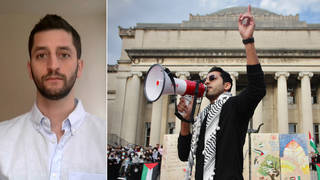
As President Bush visits wounded soldiers at the Walter Reed Army Medical Center in Washington DC, we take a look at what is rarely discussed in the corporate media: the thousands of U.S. soldiers wounded in the invasion and occupation of Iraq. [includes rush transcript]
President Bush predicted victory in Fallujah and wished U.S. soldiers “Godspeed” in their mission as the bloody U.S. assault on the city entered its third day.
His comments came during a visit of wounded soldiers at the Walter Reed Army Medical Center in Washington DC. It was Bush’s sixth visit to wounded troops at the veteran hospital since he launched his so-called “war on terror” in late 2001. He spent two hours with soldiers recuperating from injuries suffered in Iraq and Afghanistan. Bush said “It’s so uplifting to see their spirit, their drive to become rehabilitated, their love of their country, their support of the mission.”
While Bush was with the recuperating wounded, American casualties continued to mount. 10 U.S. troops have been killed in the bloody urban warfare in Fallujah. The total U.S. death toll in Iraq has surpassed 1,100. While the number of U.S. soldiers killed is widely reported, what is rarely mentioned is the many thousands more wounded.
- Mark Benjamin, UPI Investigations editor. He has been closely following the hidden US casualties from the Iraq war. He was awarded the American Legion’s top journalism award for 2004 for his reporting last year on the plight of hundreds of sick, wounded and injured soldiers at Fort Stewart, Ga.
Transcript
AMY GOODMAN: We are joined by Mark Benjamin. He is an investigations editor with UPI, who has closely followed the hidden U.S. casualties from the Iraq war. He won the American Legion’s top journalism prize for 2004 for his reporting last year on the plight of hundreds of sick and wounded and injured soldiers at Ft. Stewart, Georgia, and their lack of care. Mark Benjamin, welcome to Democracy Now!
MARK BENJAMIN: Thank you for having me.
AMY GOODMAN: Can you talk about the numbers, as you understand them today, of, not the dead, but the wounded?
MARK BENJAMIN: Well, with respect to the wounded, the Pentagon does report a number that it says is the number of soldiers that are wounded in the war. I think we’re running around 7,000 or 8,000 in Iraq. But what that number does not include is the number of soldiers who are wounded or ill, or injured in operations that are not directly due to the bullets and bombs of the insurgents. So, for example, as of mid-September, if you take actually Afghanistan and Iraq together, there were 17,000 soldiers who were injured or ill enough to be put on airplanes and flown out of theater, and none of those casualties, and I call them casualties because they fit the Pentagon’s definition of casualties, none of those casualties appear on any public casualty lists.
AMY GOODMAN: How do you get these figures, and why aren’t they being more reported?
MARK BENJAMIN: You have to ask the right questions. If you go to the Pentagon, and you take their own definitions of casualties and ask you them the right questions, they will give you some answers. So, for example, the reason why I started asking questions is that I visited eight major military facilities around the country — well, in the United States and Europe, and frankly, I just saw more soldiers that were hurt than seemed to be reflected in the Pentagon reports. They — the Pentagon says, when I asked them what was on and not on their casualty lists, they said they weren’t keeping track of the number of soldiers. The Pentagon told me we are not keeping track of the number of soldiers who are wounded or ill or injured that are not hit by the enemy’s bullets and bombs. If you go to the Pentagon’s transportation command, however — these are the people that put wounded soldiers on airplanes and fly them out — they will give you some data. What the Pentagon says is, well, not every single person who is put on an airplane and flown out of Iraq is a casualty; some of them may have appendicitis, and so on and so forth. But they won’t tell you how many of each category there are. So in other words, we know that there are thousands and thousands and thousands of potential casualties that are not being reported.
AMY GOODMAN: And how are these troops being treated? You could refresh people on your groundbreaking story on Ft. Stewart, Georgia, and what was happening there. But what has happened since, as well?
MARK BENJAMIN: What has happened since is that essentially the treatment of the soldier, I think, depends to a certain extent on how badly they’re injured, how they’re injured and what stage of the treatment they’re in. So for example, the military is very, very good at getting to wounded soldiers in the field and putting them on airplanes, flying them out of Iraq, taking them to Lahnstuhl, Germany, taking care of them and bringing them to Walter Reed. These are people hit by, for example, improvised explosive devices and missing arms and legs. As you go down the spectrum of casualties in terms of people that have their backs broken in car accidents, or frankly, people that have mental problems which is a growing and very serious toll from this war, which I think is also underreported, the treatment, at least according to soldiers, is not as good. I would add one other thing. The new, I think the latest, phenomenon that seems to be occurring is we now see an increasing number of soldiers reaching the end of their medical care with the military, and being put out of the military, now in the hands of the VA. And while I believe there’s some very, very capable people and caring people at the Veteran’s Administration, they appear to be overloaded, and we’re reaching a situation now where sick, wounded and otherwise hurt soldiers are being essentially put out of the military and not getting the kind of care that I think they would like at the VA. And I think there are some soldiers that are starting to fall through the cracks.
AMY GOODMAN: Mark Benjamin, as when you see once again, President Bush going to Walter Reed Hospital, your final thoughts?
MARK BENJAMIN: I’m certainly glad that the president is visiting the troops. I think he’s probably seeing part of the picture. For example, I suspect they probably took him to the — one of the wards there where they have more of the traditional war injuries as opposed to, for example, Ward 54, which is where I visited, which is the in-patient psychiatric ward where we have soldiers who frankly have been driven deeply insane by combat. I wish that the American people knew more about what is happening with respect to the toll of this war, because I think it’s a lot bigger and a lot more troubling than most people know.
AMY GOODMAN: Mark Benjamin, I want to thank you for being with us. UPI reporter.
MARK BENJAMIN: Thank you for having me.













Media Options